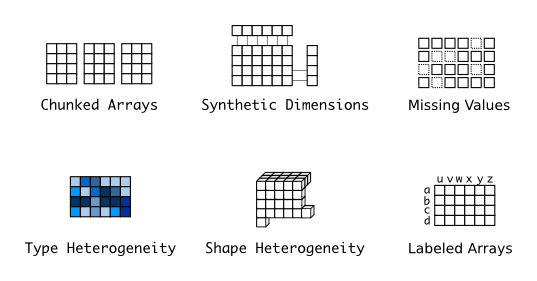Overview¶
Blaze Abstracts Computation and Storage¶

Several projects provide rich and performant data analytics. Competition between these projects gives rise to a vibrant and dynamic ecosystem. Blaze augments this ecosystem with a uniform and adaptable interface. Blaze orchestrates computation and data access among these external projects. It provides a consistent backdrop to build standard interfaces usable by the current Python community.
Demonstration¶
Blaze separates the computations that we want to perform:
>>> from blaze import *
>>> accounts = symbol('accounts', 'var * {id: int, name: string, amount: int}')
>>> deadbeats = accounts[accounts.amount < 0].name
From the representation of data
>>> L = [[1, 'Alice', 100],
... [2, 'Bob', -200],
... [3, 'Charlie', 300],
... [4, 'Denis', 400],
... [5, 'Edith', -500]]
Blaze enables users to solve data-oriented problems
>>> list(compute(deadbeats, L))
['Bob', 'Edith']
But the separation of expression from data allows us to switch between different backends.
Here we solve the same problem using Pandas instead of Pure Python.
>>> df = DataFrame(L, columns=['id', 'name', 'amount'])
>>> compute(deadbeats, df)
1 Bob
4 Edith
Name: name, dtype: object
Blaze doesn’t compute these results, Blaze intelligently drives other projects to compute them instead. These projects range from simple Pure Python iterators to powerful distributed Spark clusters. Blaze is built to be extended to new systems as they evolve.
Scope¶
Blaze speaks Python and Pandas as seen above and also several other technologies, including NumPy, SQL, Mongo, Spark, PyTables, etc.. Blaze is built to make connecting to a new technology easy.
Blaze currently targets database and array technologies used for analytic queries. It strives to orchestrate and provide interfaces on top of and in between other computational systems. We provide performance by providing data scientists with intuitive access to a variety of tools.